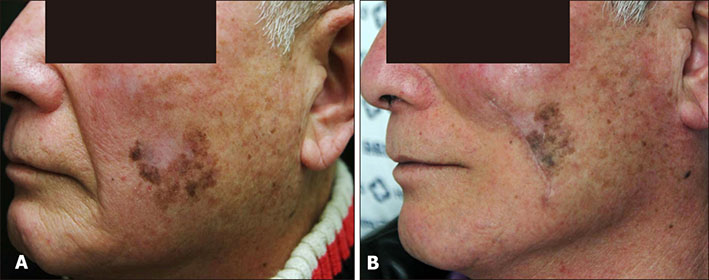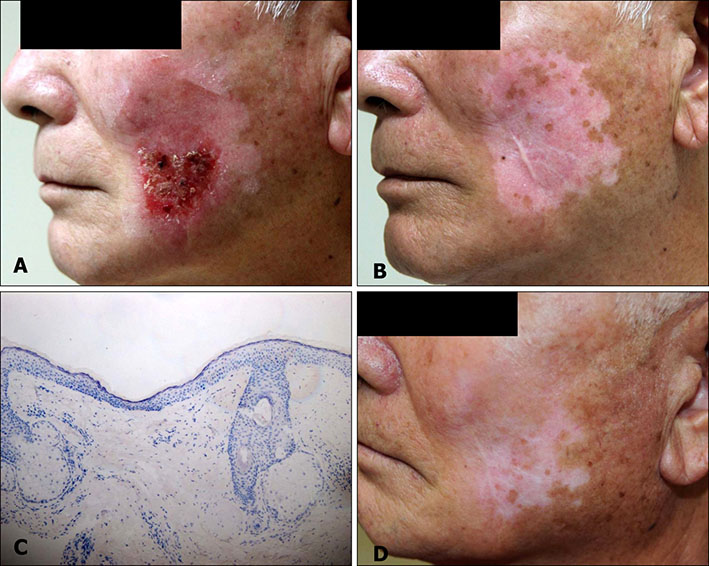Ann Dermatol.
2018 Aug;30(4):454-457. 10.5021/ad.2018.30.4.454.
Development of Vitiligo-Like Depigmentation after Treatment of Lentigo Maligna Melanoma with 5% Imiquimod Cream
- Affiliations
-
- 1Department of Dermatology, Chonnam National University Medical School, Gwangju, Korea. sjyun@chonnam.ac.kr
- KMID: 2457523
- DOI: http://doi.org/10.5021/ad.2018.30.4.454
Abstract
- A 69-year-old man presented with a black irregular patch on his left cheek. Skin biopsy revealed lentigo maligna melanoma in situ. He was treated via partial excision of the melanoma, followed by the application of 5% imiquimod cream every other night for 6 to 8 hours. The patient experienced severe local inflammation accompanied by burning, edema, and erythema, as well as oozing and crusting. The patient discontinued using the imiquimod cream after 15 applications because of the inflammation. Depigmentation was noted in the treated area 3 months after the initiation of treatment with imiquimod cream. Histological examination using Melan-A staining of the depigmented area revealed an absence of melanocytes, which is consistent with vitiligo. The depigmented lesions improved considerably after a 5-year follow-up, and there was no recurrence of melanoma.
Keyword
MeSH Terms
Figure
Reference
-
1. Swetter SM, Chen FW, Kim DD, Egbert BM. Imiquimod 5% cream as primary or adjuvant therapy for melanoma in situ, lentigo maligna type. J Am Acad Dermatol. 2015; 72:1047–1053.
Article2. Ellis LZ, Cohen JL, High W, Stewart L. Melanoma in situ treated successfully using imiquimod after nonclearance with surgery: review of the literature. Dermatol Surg. 2012; 38:937–946.
Article3. Brown T, Zirvi M, Cotsarelis G, Gelfand JM. Vitiligo-like hypopigmentation associated with imiquimod treatment of genital warts. J Am Acad Dermatol. 2005; 52:715–716.
Article4. Stefanaki C, Nicolaidou E, Hadjivassiliou M, Antoniou C, Katsambas A. Imiquimod-induced vitiligo in a patient with genital warts. J Eur Acad Dermatol Venereol. 2006; 20:755–756.
Article5. Senel E, Seckin D. Imiquimod-induced vitiligo-like depigmentation. Indian J Dermatol Venereol Leprol. 2007; 73:423.
Article6. Kwon HH, Cho KH. Induction of vitiligo-like hypopigmentation after imiquimod treatment of extramammary Paget's disease. Ann Dermatol. 2012; 24:482–484.
Article7. Kumar B, Narang T. Local and systemic adverse effects to topical imiquimod due to systemic immune stimulation. Sex Transm Infect. 2011; 87:432.
Article8. Serrão VV, Páris FR, Feio AB. Genital vitiligo-like depigmentation following use of imiquimod 5% cream. Eur J Dermatol. 2008; 18:342–343.9. Mendonça CO, Yates VM. Permanent facial hypopigmentation following treatment with imiquimod cream. Clin Exp Dermatol. 2006; 31:721–722.
Article10. Jacob SE, Blyumin M. Vitiligo-like hypopigmentation with poliosis following treatment of superficial basal cell carcinoma with imiquimod. Dermatol Surg. 2008; 34:844–845.
Article11. Sriprakash K, Godbolt A. Vitiligo-like depigmentation induced by imiquimod treatment of superficial basal cell carcinoma. Australas J Dermatol. 2009; 50:211–213.
Article12. Schön MP, Wienrich BG, Drewniok C, Bong AB, Eberle J, Geilen CC, et al. Death receptor-independent apoptosis in malignant melanoma induced by the small-molecule immune response modifier imiquimod. J Invest Dermatol. 2004; 122:1266–1276.
Article13. Kim CH, Ahn JH, Kang SU, Hwang HS, Lee MH, Pyun JH, et al. Imiquimod induces apoptosis of human melanocytes. Arch Dermatol Res. 2010; 302:301–306.
Article14. Mashiah J, Brenner S. Possible mechanisms in the induction of vitiligo-like hypopigmentation by topical imiquimod. Clin Exp Dermatol. 2008; 33:74–76.
Article15. Dahl MV. Imiquimod: a cytokine inducer. J Am Acad Dermatol. 2002; 47:4 Suppl. S205–S208.
Article



